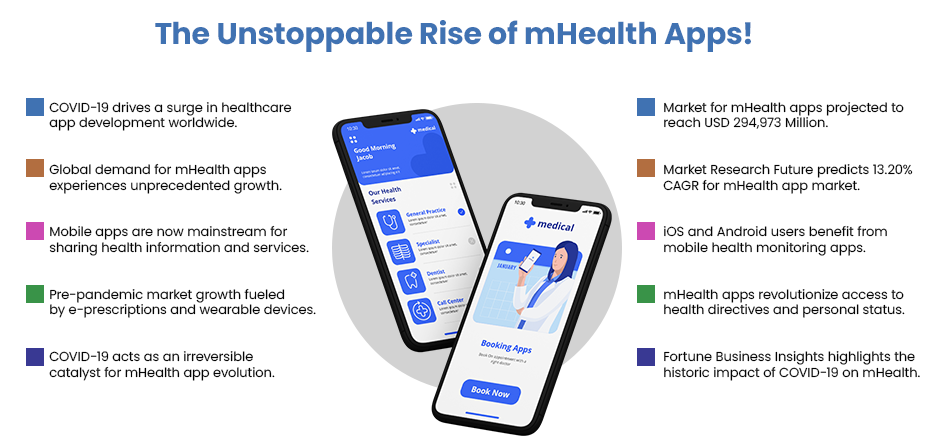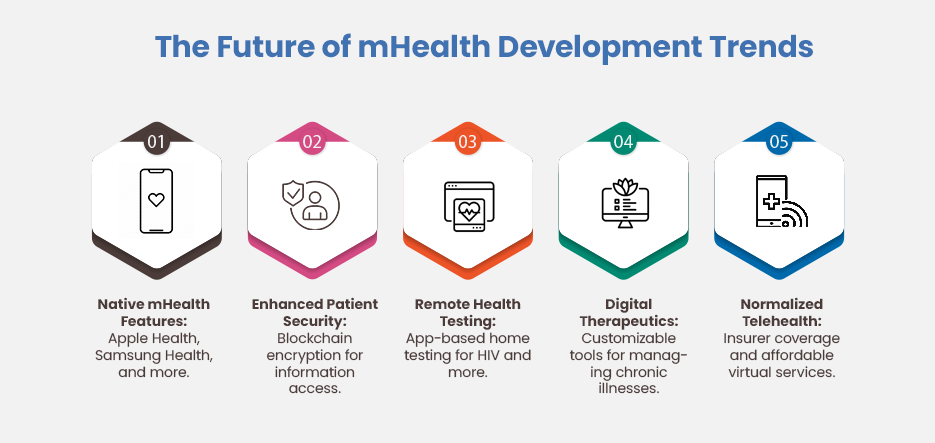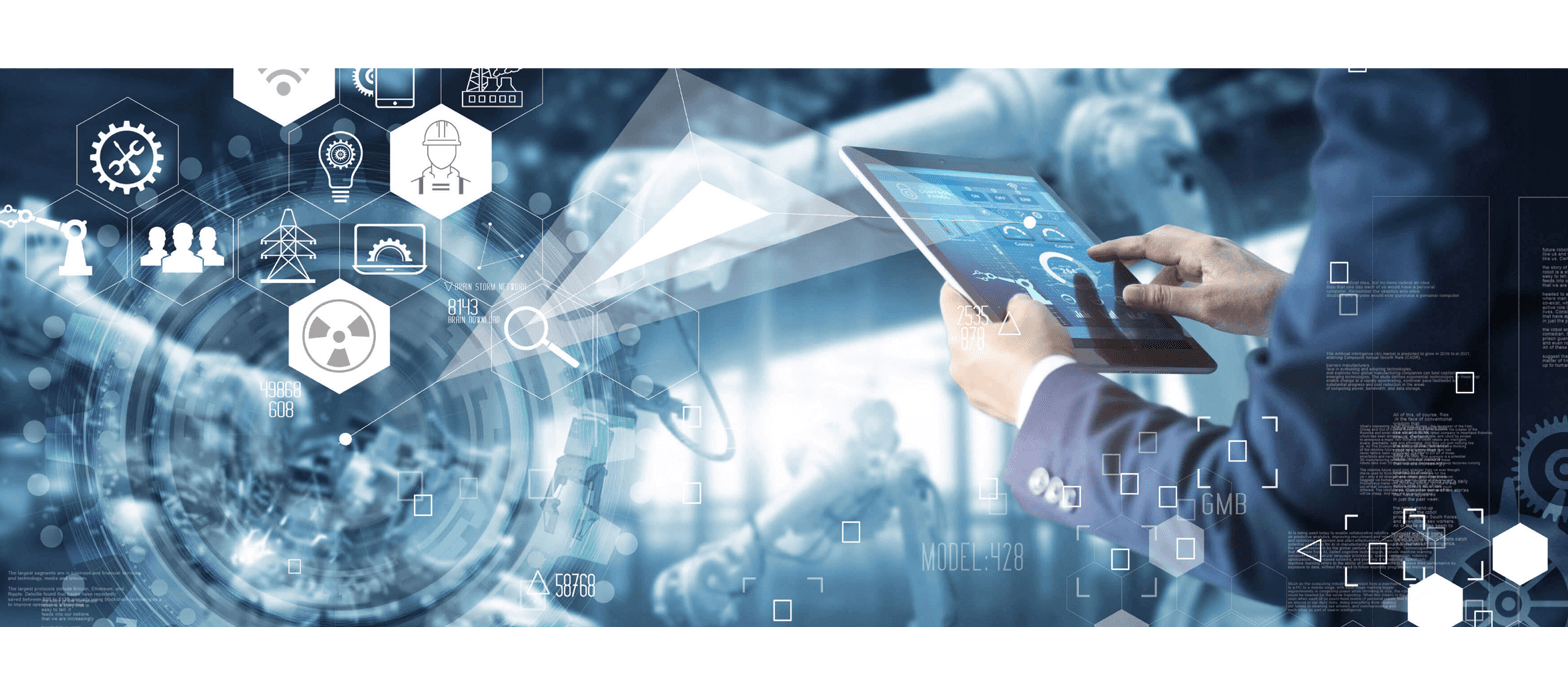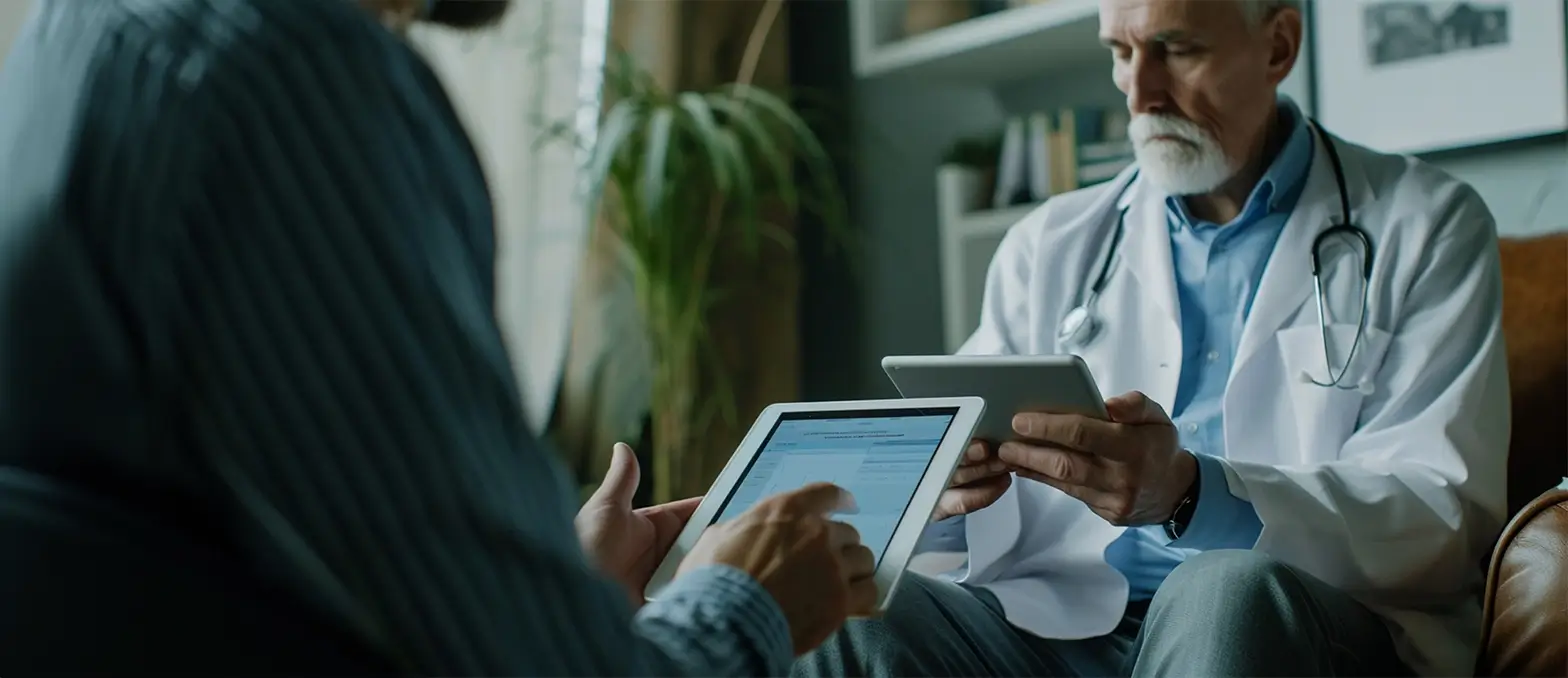Table of Contents
As we head into a new year, we’re sure about how to kickstart our health and fitness journey. What if apps can help us do this? And if they can, is there both short-term and long-term evidence that apps can do just this? The rate of mhealth app development centred on public health and safety has accelerated in recent times, particularly over the last three years in the 2021-2023 period. The development and product space of mobile health (mHealth) technology is important for all of us, a fact even more undeniable after the chaos of the first global pandemic of this century.
Read on to learn more about how mobile mHealth app services can make us healthier and safer.
The Trajectory Of Mhealth Apps — Health And Safety Software For Mobile Devices
The rapid upswing in healthcare app development for public health and safety is predominantly for the Covid-19 pandemic. A report from Fortune Business Insights emphasizes the historic nature of the pandemic with their statement, “The global impact of COVID-19 has been unprecedented and staggering, with mHealth apps witnessing a significant positive demand shock across all regions amid the pandemic.” For iOS (Apple) and Android (Google) users alike, worldwide use of mobile apps designed to share health information, monitor health directives and personal health status, and a range of services is now in a phase of mainstreaming.

Prior to the pandemic, use of mHealth apps was far less extensive with one 2016-2018 report from Grand View Research outlining key market factors based on “the e-prescription system, wearable device manufacturers, and mobile health app providers, has contributed significantly to the market growth.” In the four years since that report, mHealth apps have experienced a seismic evolution due to how the Covid-19 pandemic functioned as an irreversible catalyst for both the use of mHealth apps and the scope of the apps themselves. As of December 2022, experts from Market Research Future report that the market for this app niche will continue its boom — the market is projected to reach USD 294,973 Million by 2030 at 13.20 percent CAGR during the forecast period of 2022-2030.
The importance of healthcare app development for public health and safety
In 2025 and the years ahead, when we talk about meditech mhealth apps designed to support healthcare and safety this now encompasses the following health and safety areas, plus many more:
- Personal medical history
- Healthcare goals including fitness
- Practitioner visits to hospitals and clinics
- Insurance claims
- Telemedicine and remote health services
- Prescriptions and pharmaceutical documents
- Laboratory, screening, and imaging results
- Appointment management and routine check-up planning
- Vaccine and medical document storage
- Checking in with their location with loved ones
- Wearable health and diagnostics trackers
These areas of use are diverse and nuanced while also beginning to function as medical and health services — for public health, private health, and civic safety providers. Custom mobile app development service in these areas matters for numerous reasons, not least because of how these platforms work to: support individual and collective well-being (Core Priorities of the World Health Organization [WHO]); leverage technology to promote our unique personal interests in terms of our health and context; and, provide equitable access to services where financial, geographical, and supply challenges exist.
As far back as 2012, WHO celebrated mHealth with an early endorsement over a decade ago, “The use of mobile and wireless technologies to support the achievement of health objectives (mHealth) has the potential to transform the face of health service delivery across the globe.” The relative accessibility of mHealth could be the key to overcoming the challenges that put so many people on uneven footing with health and safety. The multiplication of avenues that provide access to health and safety services with technology — inclusive of the lowering costs of internet and devices, remoteness no longer cutting off connection to specialists and services, and language barriers not stopping vital communication with practitioners — show just how genuinely life-changing mHealth apps can be for millions of people.
How safety is promoted through quality mobile app development?
Safety is central to how we talk about health due to both classifications around illness preventability and the global prevalence of injury as a cause of an average of 8% of deaths. Zooming out and considering the social impact of injury and violence, there are also debilitating health conditions deriving from compromised safety that include mental illnesses such as trauma and stress. Ultimately the ability to improve personal, environmental, and social safety is intertwined with this conversation about how mHealth can change the world.
As per the leading mobile app development company, individual safety needs can be targeted with mHealth apps. All this from in-built systems like Find My Friends on iPhone and Google Maps Location Sharing that works across smartphones. On a macro level, the modernization and digitization of many essential government services increases the safety of citizens. Accessing key civic services is now virtually effortless via official apps that are both inbound and outbound for police, ambulance, and fire brigades.
Many governments are communicating with people in their regions with weather and emergency warnings that function to protect the community as a whole with the added benefit of immediacy and relevant flow-on information available at their fingertips if they need to review their activities.
Why Was It Taken In Consideration?
Safety and its symbiosis to best mhealth apps was in testing phase throughout the Covid-19 wave. The introduction of a mHealth app services keep citizens safe and prevent virus spread. The different services like ‘check-in’ Contact Tracing apps, health outbreak communications and vaccine certificate management made the job easier. It also came up with transit and border passes, and government health and welfare service systems. You got an idea on how these systems work. There are mHealth positives that support safety significantly.
During Covid-19 and now in the recovery period, we’ve seen how mHealth apps enable triage management. This is done at a safe distance from hotspots or high-spread areas. This includes hospitals as well. Telehealth services can cover different medical needs as well. So people can receive treatment even if they can’t leave their homes. This technology is literally changing the face of how people can prioritize and uphold personal safety and wellbeing. In this next-generation reality of how people can manage their safety and hence their holistic wellbeing, there is so much to be optimistic about especially as medical app developers dedicate themselves to the dynamic nature of health.
The status of the mHealth app market for medicine delivery, pharmacy products and pharmaceuticals, and medical services
The iPhone 3G revolutionized the way we use mobile phones in 2007 and since then there has clearly been profound shifts in not only what we demand but also what we need our devices to do. As touched on in the previous sections. mHealth apps and the work of the developers behind these products is now central to how we all proactively care for our health, work to prevent injury and illness, and access services. Most-recent data for Q3 2022 from Statista shows that in the U.S., the world’s largest user market of both iOS and Android apps, there are 41,517 iOS mHealth apps and 54,546 Android mHealth apps available. Although overall market presence of mHealth apps has declined slightly compared to the growth of 2020-2021. Largely based on a health-crisis market — 2022 numbers are above 2019 numbers for the same markets.
When it comes to specifications, the interface for medicine delivery, pharmacy products and pharmaceuticals, and medical services can vary. To accurately & legally deliver a range of services and products designers, developers are beholden to all kinds of compliance regulations. Which is inarguably due to the severity of risk tied to mHealth if errors and misinformation occur. In regards to equity, researchers have also identified the inherent danger to low-resource users based on the intersectional issues at play. In an article for the Journal of Medical Internet Research edited by Gunther Eysenbach. A group of medical doctors and academics agree say that. “mHealth apps targeted to low-resource settings must be evidence-based, efficient, safe, and tailored to the users and their needs. To achieve these goals and maintain usability, special focus should be given to four specific themes. Interface design, feedback, navigation, and terminology.”
Right now, the mHealth app market roughly covers apps that are:
- Apps for professionals and medical facilities — that their patients as well as their teams can use
- Apps for patients — that can be used for a wide variety of health needs
Across these two categories, there are a multitude of apps already available inclusive of: apps for at-home workouts and fitness monitoring, appointment and reminder apps for individual medical services, payments and claims, document and results storage, pharmacy access and medication information, and, even ‘Uber’ app clones for medicine delivery.
Developing apps for medicine delivery, pharmacy products and pharmaceuticals, and medical services
Looking at mHealth apps available now and down the line at those in development, it’s safe to say that this area of technology will continue redefining how we approach health and it will be at the heart of human beings thriving well into the future. The combination of improved health promotion & advanced medical smart technology is crucial and will have a significant impact in the field. Business Wire reports that, “These devices have an impact far beyond typical consumer uses. Like fitness and activity tracking and have penetrated the area of medical applications. Such as diagnosis, monitoring and, to a certain extent, even the treatment of chronic diseases.”
In their practical implementation, mHealth apps currently have a range of designs. What is a main design differential for users is how complex an interface will be. On the user side, apps for professionals and medical facilities tend to be somewhat more administrative than for patients. The distinction between professional use and personal use also shapes the interface even if the back-end requires high-volume development work. For example, health professionals might work with mobile app developers to provide a very high security app for service, such as the Island of Jersey’s My mHealth app that is designed for managing their own health condition, that needs to keep patient data secure. While the forward-facing design will be user-friendly to minimize confusion & maximize a pleasant navigation experience. The back-end design and access credentials need to be high security. In the way that an app designed for simple mindfulness exercises and media is not.
What Trends Lies Ahead?
The healthcare app development services market is constantly evolving and there is what Business Wire describes as “the convergence of mHealth devices such as smartwatches and activity trackers with medical-grade products” happening. The main development trends point towards:

- Native mHealth features on devices — such as Apple Health and Samsung Health
- Greater patient security across mHealth regardless of ownership or networks — the possibility of blockchain encryption to reduce information silos and ease of records access
- Being able to test health remotely — including managing major health crises like the human immunodeficiency virus (HIV) with app-based home testing
- Digital therapeutics (DTx) — the ability to manage chronic illnesses through remote therapies, support frameworks, information, and customizable community tools
- Normalized telehealth — including coverage of virtual services by insurers and more economical treatments
What does this mean for confidential health records and citizen privacy?
To fairly discuss the mHealth apps, we can’t overlook those that are benefiting health. Also, those that are potentially putting users at risk. A concern at the forefront of the introduction of mHealth apps is fears around confidentiality. It all includes health records and citizen privacy. As the 2022 data breaches and subsequent ransoming of private user data in countries such as Australia show — both of medical insurers and government health departments — it’s fair to question whether the health positives outweigh the personal violation negatives.
As per the top mobile app development company in the United States, there is serious pressure on mHealth providers and therefore medical app developers to get cybersecurity right. So, it’s difficult to specify exactly what options are available to individual users when using government mHealth services. As more countries digitize every person becomes more vulnerable. Furthermore, these are situations in a state of flux and daily changes. So, what happens from here remains to be seen & it is down to each person to manage their data. All this to the best of their capabilities and to the extent of their control for better results.
What Does The Data Say?
As per the healthcare app development companies, beyond the extreme violation of data hacking, there are ongoing debates about the security of health apps and individual privacy. So, Cheryl Winokur Munk reports for CNBC that there is still risk tied to personal information. Potentially being made “available to or intercepted by third parties” on these health devices and their software. Also, Winokur Munk writes, “Data collected by a fitness app is not protected like health information under the law. Making social & location settings, and login credentials, critical for a user to set properly before making these devices part of their daily life.”
Big brands for mHealth devices and apps, even household names like Fitbit, now owned by Google, can still be attacked; despite this, experts recommend prioritizing purchasing products from larger companies that have the resources to design secure software. Other than shopping for brands that have an interest in protecting users, personal cybersecurity strategies are still on the rise. It is certainly the digital hygiene approach in consideration by many companies. Checking the security of smart devices especially smart watches etc, applying two-factor authentication credentials and strong passwords. It only shares location data with a limited number of people. This can go some way to prevent bad actors from accessing private health information.
Final Thoughts
In closing, there are still many areas of mHealth hybrid apps and whether they can make us safer and healthier. Significant responsibility applies in the area of mHealth. This is because of the wide group of stakeholders. It includes governments, private companies, medical professionals, and individuals. While both internal and external stakeholders benefit in this new era in health. Medical practitioners have a greater opportunity to deliver quality care and patients. They have the chance to receive it based on their context. Unfortunately, it’s not a simple or default solution for all people.
As we have already taken in context, there are still hurdles to overcome with security and confidentiality. It also includes accuracy of services, truly personal care, and legislative integration. Technology comes with its own set of ethical conundrums and minefields. From scams like Theranos to technology fraud under the guise of medical deepfake disinformation, there is still a long way to go before mHealth is a trouble-free industry. The technology has become smarter such as with robotic diagnostics in the health space. The ethics of AI and machine learning solutions for the individual and the collective needs testing. As an evolving area of technology, ethics and medical AI will be part of the everyday discussion. If you desire to know more you can connect with the custom app development agency A3Logics. You get all the support at your convenience.
Book 30 Minutes Free Consultations with A3logics Experts to Start Your App Journey Today!
FAQs
How can health apps aid?
The FDA believes that mobile apps could aid individuals improve their health habits by motivating positive change for better health, and having access to useful information about health much more quickly.
What types and health applications are there?
Thanks to mobile app development services USA, there are a variety of health apps on the market. These include apps for:
- Nutrition: Many apps provide an estimate of calories consumed so that you know exactly how much you’re eating.
- Sleep: There are apps that track and record details like the amount and quality of sleep you slept.
- Health: Various apps can assist you in keeping track of the amount of steps you’ve taken and/or the distance you bike or run.
- Stress: These include apps to help relax the mind, increase awareness, or even meditation exercises.
- Reminders for your medication: These can help remind you to take your medication at the appropriate time.
- Stopping smoking: These apps aim to aid smokers who want to quit according to their patterns of smoking as well as triggers and moods.
- Cancer patients: These are apps created to aid patients with cancer by coordinating their queries with their doctors, giving them information regarding the diagnosis, and assisting in taking care of their everyday needs.
Are health apps designed to replace your healthcare provider?
No. The health apps can assist you in keeping track of your medical and related activities. They’re not designed to replace your physician. It’s crucial to stay on top of the appointments you make in person. In those visits, you should give the information you’ve collected from any health app you use. This will aid your doctor in working with you to improve your general health.
What is the best way to locate a health app that’s right for me?
If you’re considering making use of an app for health, ask your physician for any suggestions.
As per custom mobile app development company experts, other aspects to be considered include:
- Consider your health-related goals and then find out what apps to help you achieve them.
- Online reviews and reading app-store reviews to see what other users are saying about the app.
- Avoid health apps that promise too much. If the app seems too appealing to be real It could be.
- You are looking for apps that provide self-monitoring, permit goals, provide reminders, and provide social support.





